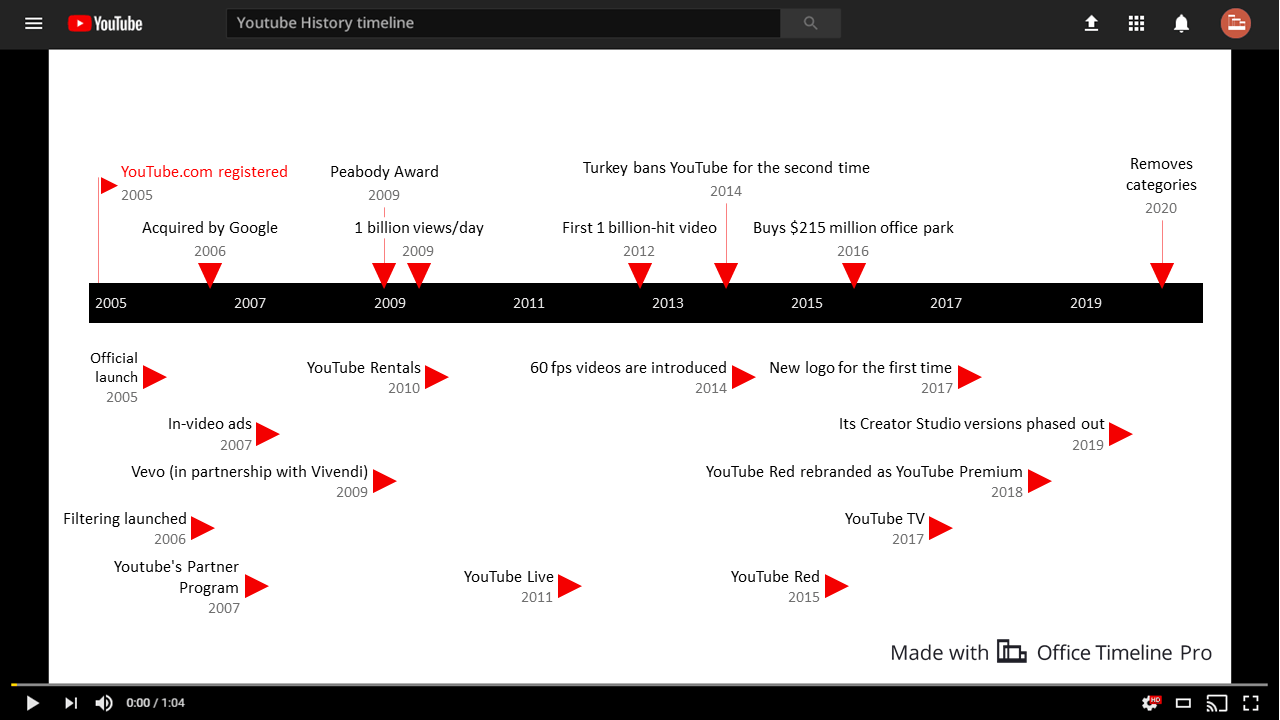 |
| Find the image here. |
YouTube first launched in 2005 as a platform for users to share and consume content without restriction, a mission that has since been altered as the platform grows. Today, YouTube is the most popular video distribution platform on the internet. Every month 4 billion hours of video is viewed and every minute an estimated 500 hours of video content is uploaded.
The company was founded on February 14th by Chad Hurley, Steve Chen, and Jawed Karim. The domain name, trademark, and logo were registered in their headquarters located above a pizzeria in California. The three former Paypal employees reportedly created the idea at a San Francisco dinner party in 2004 when voicing frustrations about the difficulty of sharing online clips. The three wanted a way for the general public to share their "home videos" (Hosch, 2021).

This timeline can be found here. |
Originally, the founders wanted the platform to be a place where people would upload videos introducing themselves and saying what they are interested in. This, however, did not catch on and the idea was pivoted to the general sharing site we know today.
A little over a year later YouTube launched its beta version and the first video was uploaded. The video, which is included below, was uploaded by founder Jawed Karim and is entitled "Me at the Zoo."
Today, YouTube is known to be used by many companies for marketing. This immense marketing potential was first identified by Nike. The brand holds the title of the first viral video clip on the platform. The video was an ad that included a clip of Brazilian soccer player Ronaldinho receiving a pair of Golden Boots. This video was the first to hit 1 million views on the platform. Nike was also one of the first major companies to embrace YouTube's promotional potential.
Since the promotional potential of YouTube has become an integral part of the platform. This, in tandem with YouTube's Partner Program and AdSense, content creates are able to have full-time jobs through YouTube. In 2006, Google purchased YouTube and helped continue the success by combining the site's current success with the search engine's large amount of internet traffic. Now, Google is able to target specific ads embedded in the videos a person watches. Additionally, in 2019 the website added a 'two-ad' feature. This means that the website can show two ads at once, increasing the revenue gained from videos.
Impact
Though full-time content creators seem ubiquitous today, YouTube was a game-changing platform that paved the way for the profession. It changed the face of marketing by increasing targeting ability. Meaning, specific groups consume specific YouTube content. Google has the ability to gather information about a consumer from other spots on the internet and put this information to use on YouTube. This served as a model for the social platforms to follow.
The platform itself was pivotal for the way information is communicated and shared. Class lectures often are incomplete without a YouTube video. We are able to look back on political events, listen to music, watch videos, and even produce our own content. YouTube was one step in communications big move to the users consuming and creating.
Though, YouTube is by no means perfect. The nature of user-generated content means content with misinformation or potentially harmful or dangerous content could be viewed. This problem has especially become evident with children and their use of YouTube. Due to the platform and others like it, children are being exposed to adult content at younger ages with little to no regulation.
Even if a child is consuming age-appropriate content, the YouTube algorithm could suggest inappropriate content to watch next because it mimics the elements of the previous content (Papadamou et al., 2019). YouTube has implemented an entire platform with parental controls known as YouTube Kids. A study in 2019 found that children are likely to encounter inappropriate videos when randomly browsing YouTube and that the current countermeasure is ineffective at detecting inappropriate content for children (Papadamou et al., 2019).
Additionally, like many of its social media counterparts, YouTube's algorithm is known to sway political views by pushing radical content that is concurrent with your content consumption habits, furthering the gap between the right and left. A New York Times article suggests that once one seeks information on specific topics, the algorithm is likely to suggest similar conspiracy theories about the topic you researched (Tufekci, 2018). This means any person that has access to YouTube, no matter how young is being radicalized as soon as they seek any information about politics. This is threatening to our democracy, as we need educated voters to make decisions.




No comments:
Post a Comment